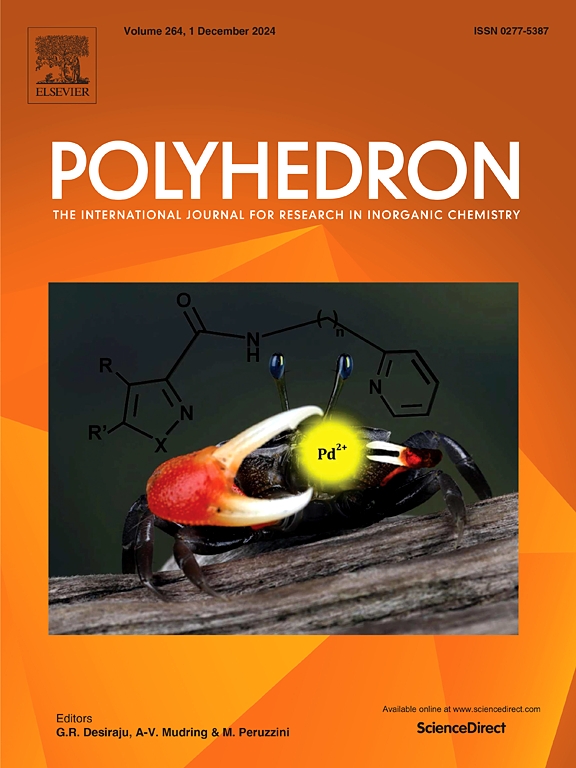发光[(2-PBO)CuILP]配合物:合成、晶体结构、性质及TD-DFT计算
IF 2.4
3区 化学
Q2 CHEMISTRY, INORGANIC & NUCLEAR
引用次数: 0
摘要
本文报道了一系列新的[(2-PBO)CuILP]型发光配合物1-6及其在VOCs荧光检测中的应用。这些CuI配合物(除1为cur外)由二亚胺配体2- pbo(2-(2′-吡啶基)-苯并唑)和5个含p配体(LP) PPh3(1 - 2)、PPh2Cy(3)、o-Tol3P(4)、TXP24(5)和TXP25(6)构成,其中PPh3 =三苯基膦、PPh2Cy = 4-环己基二苯基膦、o-Tol3P = 4-三(o-tolyl)-膦、TXP24 =三(2,4-二酰基)膦、TXP25 =三(2,5-二酰基)膦。所有配合物均具有四面体CuIN2P配位的孤立结构。TD-DFT计算将其低能紫外吸收带分配到Cu-I片段到2-PBO的混合(XL + ML)CT1跃迁,提出了类似分配的(XL + ML)CT激发态作为光致发光(PL)的来源。发现磷化氢配体的修饰对这些材料的PL性能影响很小。制备了一种基于配合物2的薄膜传感器,通过显著的PL增强和气相变色行为实现了VOCs的检测。本文章由计算机程序翻译,如有差异,请以英文原文为准。
![Luminescent [(2-PBO)CuILP] complexes: Synthesis, crystal structures, properties, and TD-DFT calculation](https://img.booksci.cn/booksciimg/2025-5/102303850141778127787.jpg)
Luminescent [(2-PBO)CuILP] complexes: Synthesis, crystal structures, properties, and TD-DFT calculation
We report herein a series of new [(2-PBO)CuILP] type luminescent complexes 1–6 and their application in fluorescent VOCs detection. These CuI complexes (except 1 as CuBr) are constructed by a diimine ligand 2-PBO (2-(2′-pyridyl)-benzoxazole) and five P-containing ligands (LP) PPh3 (1–2), PPh2Cy (3), o-Tol3P (4), TXP24 (5), and TXP25 (6), where PPh3 = triphenylphosphine, PPh2Cy = 4-cyclohexyldiphenylphosphine, o-Tol3P = 4-tri(o-tolyl)-phosphine, TXP24 = tris(2,4-xylyl)phosphine, and TXP25 = tris(2,5-xylyl)phosphine. All complexes exhibit isolated structures with tetrahedral CuIN2P coordination. TD-DFT calculations assign their low-energy UV absorption band to a mixed (XL + ML)CT1 transition from Cu-I fragment to 2-PBO, the similarly assigned (XL + ML)CT excited state is proposed as the source of photoluminescence (PL). The modification of phosphine ligands is found to have minimal impact on the PL properties of these materials. A thin-film sensor based on complex 2 was fabricated, achieving VOCs detection through remarkable PL enhancement and vapochromism behavior.
求助全文
通过发布文献求助,成功后即可免费获取论文全文。
去求助
来源期刊

Polyhedron
化学-晶体学
CiteScore
4.90
自引率
7.70%
发文量
515
审稿时长
2 months
期刊介绍:
Polyhedron publishes original, fundamental, experimental and theoretical work of the highest quality in all the major areas of inorganic chemistry. This includes synthetic chemistry, coordination chemistry, organometallic chemistry, bioinorganic chemistry, and solid-state and materials chemistry.
Papers should be significant pieces of work, and all new compounds must be appropriately characterized. The inclusion of single-crystal X-ray structural data is strongly encouraged, but papers reporting only the X-ray structure determination of a single compound will usually not be considered. Papers on solid-state or materials chemistry will be expected to have a significant molecular chemistry component (such as the synthesis and characterization of the molecular precursors and/or a systematic study of the use of different precursors or reaction conditions) or demonstrate a cutting-edge application (for example inorganic materials for energy applications). Papers dealing only with stability constants are not considered.
 求助内容:
求助内容: 应助结果提醒方式:
应助结果提醒方式:


